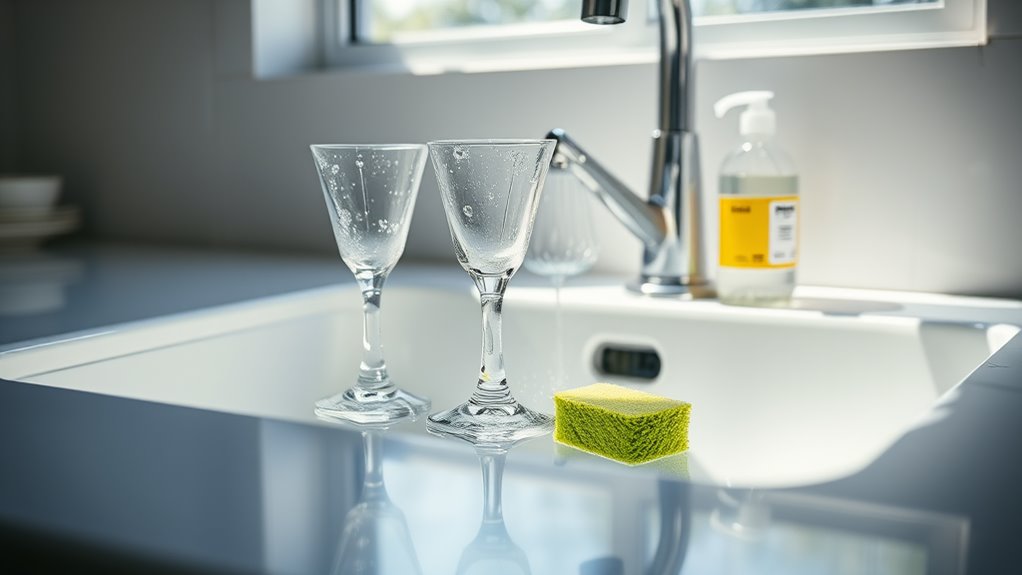No More Spotty Dishes-This Hack Works Like Magic
Are you tired of pulling dishes from the dishwasher only to find stubborn spots and streaks? You’re not alone. Those pesky marks often come from hard water minerals clinging to your glassware and plates. But don’t worry—there’s a simple, effective trick using a common household item that can change everything. Stick around to uncover how to transform your dishwashing routine into a spotless success.
Key Takeaways
- Try the vinegar hack by placing a bowl of white vinegar on the top rack for spot-free dishes.
- Rinse dishes before loading to prevent food residue from causing spots.
- Use a high-quality rinse aid to improve water sheeting and reduce droplet marks.
- Avoid overcrowding the dishwasher to ensure water reaches all surfaces evenly.
- Run a hot water cycle to enhance cleaning and eliminate spot formation.
Discovering the Ultimate Rinse Trick
Ever wondered why your dishes come out spotty even after a thorough dishwasher cycle? Let’s uncover a game-changer with this dishwashing rinse hack.
Grab a small bowl, fill it with white vinegar, and place it on the top rack of your dishwasher before starting the cycle.
The vinegar acts as a natural rinse aid, breaking down mineral deposits and ensuring a spot-free shine.
Make sure your dishwasher’s rinse aid compartment is empty to avoid mixing.
Run the cycle as usual, and you’ll notice cleaner, gleaming dishes.
Try this practical trick today for flawless results!
This simple hack not only cleans but also enhances your kitchen aesthetics with sparkling dishes.
Why Spots Appear on Your Dishes
How do those pesky spots end up on your dishes despite a full dishwasher cycle? It’s often due to hard water minerals like calcium and magnesium sticking to surfaces as water evaporates. If your rinse aid’s low, water doesn’t sheet off properly, leaving droplets that dry into spots. Food residue or overcrowded racks can also trap grime. Using an eco dishwasher setting can help by optimizing water and energy consumption for a more sustainable clean.
Check your water hardness and dishwasher setup with this table:
| Factor | Impact on Spots | Quick Check |
|---|---|---|
| Hard Water | High mineral buildup | Test water with a kit |
| Rinse Aid Level | Poor water sheeting | Inspect dispenser |
| Overloading | Blocks water flow | Rearrange dishes |
| Detergent Residue | Leaves film | Use recommended amount |
| Drying Cycle | Incomplete evaporation | Ensure heat dry is on |
Step-by-Step Guide to Spotless Results
While spots on dishes can be frustrating, you can achieve spotless results with a few targeted steps.
Start by rinsing dishes under warm water before loading them into the dishwasher to remove food residue. Next, ensure you’re using the right amount of high-quality detergent—check the manufacturer’s guidelines. Add a rinse aid to your dishwasher’s compartment to prevent water spots. Arrange dishes properly, avoiding overcrowding, so water reaches every surface. Finally, run a hot water cycle for optimal cleaning. Discover an innovative dishwashing technique that can save time and transform your routine with minimal effort.
Stick to these precise actions, and you’ll see a noticeable difference in your dishwashing results every time.
Benefits of a Flawless Dishwashing Method
A flawless dishwashing method offers you more than just clean dishes—it saves time and boosts efficiency in your kitchen routine. You’ll notice fewer repeat washes, less water waste, and a tidier sink area. Imagine reclaiming minutes for other tasks!
Here’s why it transforms your experience:
| Benefit | Impact |
|---|---|
| Faster Cleanup | Finish chores in half the time. |
| Reduced Water Use | Save on bills with less rinsing. |
| Spotless Results | Impress with pristine dishes. |
| Less Stress | Enjoy a clutter-free kitchen. |
You’ll love how this method streamlines your day! Plus, adopting an ultimate dishwashing shortcut can make post-meal cleanup even easier.
Tips for Maintaining Pristine Glassware
Ever wondered why your glassware sometimes looks cloudy despite a thorough wash? It’s often due to hard water deposits or improper drying.
To keep your glasses pristine, rinse them with a vinegar-water mix (1:3 ratio) before washing to break down mineral buildup.
Use a dishwasher detergent designed for hard water if that’s an issue.
Don’t overcrowd the rack—give each piece space for thorough cleaning.
After washing, dry with a lint-free cloth to prevent water spots.
Lastly, store glasses upside down on a clean, dry shelf to avoid dust and maintain that sparkling clarity.
For an even easier approach, try loading your dishwasher strategically to save time with efficient dishwasher shortcuts.

